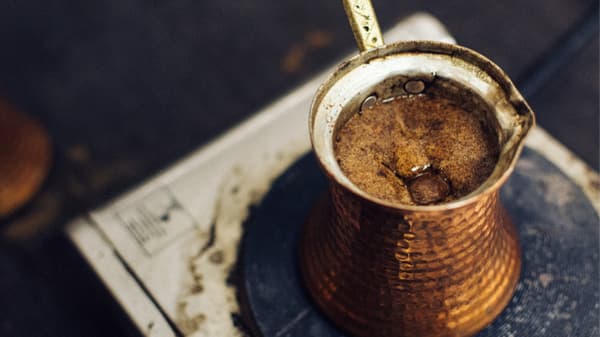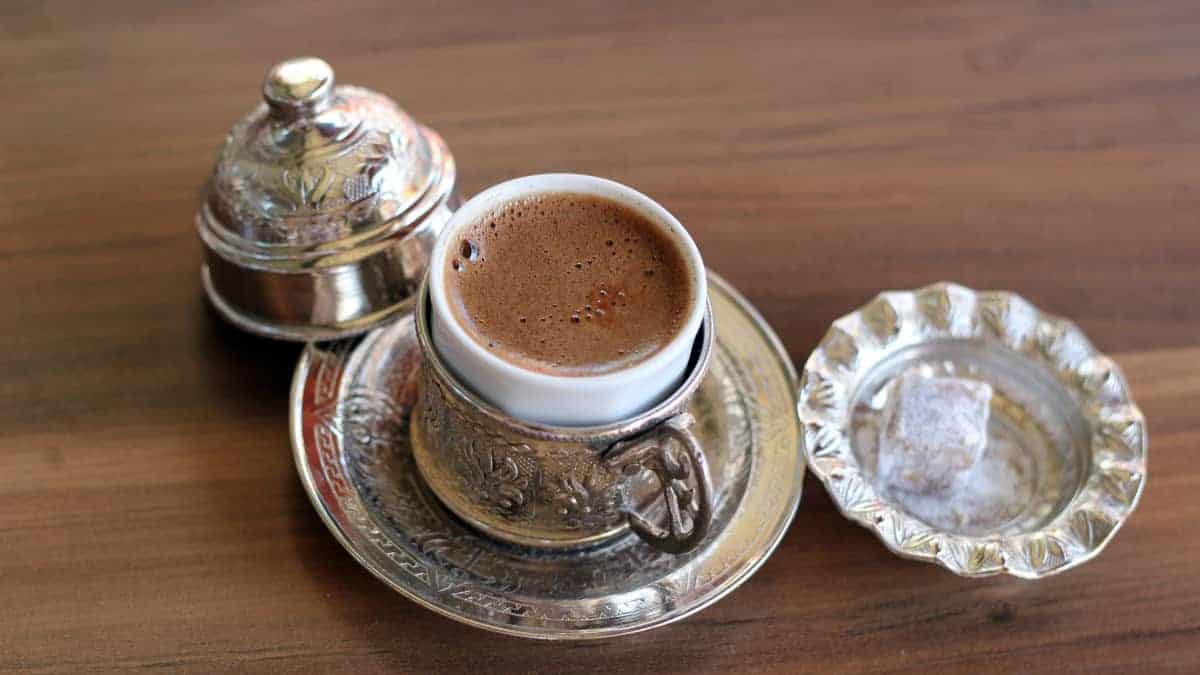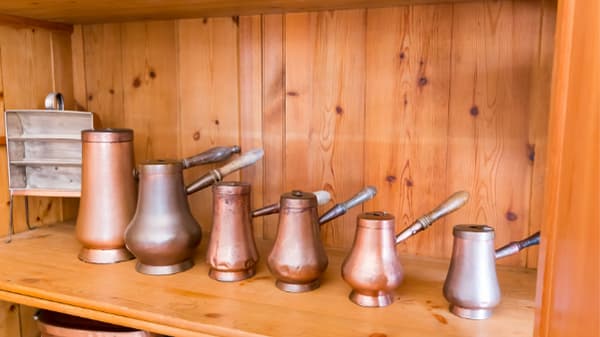How To Make Turkish Coffee With Or Without An Ibrik Recipe
Strong. Unfiltered. Passionate.
Those words could describe the Turkish people. But those are also appropriate words to describe traditional Turkish coffee or Türk Kahvesi.
Loved around the world, Turkish coffee is admired for its unusual brewing process and prized for its strong taste.
Interestingly, making Turkish coffee at home is much easier than you might think. In this article, I’ll guide you on how to make Turkish coffee at home using specialty coffee, even if you don’t have an Ibrik or Cezve.
But first, if you’re unacquainted, you might have a simpler question first:

What Is Turkish Coffee?
Coffee history in Turkey goes back some 500 years. Coffee arrived in Istanbul in the early 1500s, apparently from Yemen.
Turkish coffee houses soon began to blossom. Men gathered to drink coffee and discuss social issues, politics, and life in general.
Coffee was readily accepted into popular culture, and over time each household developed its own recipe. Naturally, they delighted in the taste of this strong drink, made even stronger by the unusual way they brew it.
Turkish coffee is brewed in an Ibrik, which also goes by the name of Cezve. Used throughout the Middle East and Eastern Europe, an Ibrik is a small metal coffee brewer.
It is often made of brass or copper, although ceramic ones do exist. A Cezve has a long handle to make it easier to manage the hot contents and a curved rim that makes it easy to pour out.
And naturally, this special method has a special coffee brewing process, which I’ll describe later in the article. The result is a thick, foamy coffee with an intense taste.

How To Make Turkish Coffee
How Turkish coffee is brewed varies by region. There’s a special coffee recipe for each area, as well as each household. But they all have five things in common:
- The Irbik brewing method
- Foamy texture
- Served in tiny Turkish coffee cups
- Lokum, chocolate, or any sweet treat served on the side
A Cezve or Ibrik is a small, long-handled Turkish coffee pot. This pot is specifically used to prepare coffee. It has a wide base and narrows at the neck. Ibriks come in sizes from 1 cup to 8 cups, but they generally hold about two cups of water.
If you’re planning to buy an Ibrik, keep in mind that during brewing, the coffee must reach the neck of the pot to brew properly. So don’t oversize it.
This brewing method is so popular there’s even an Ibrik Championship. It attracts international competitors to brew alongside national stars such as Turgay Yildizli, a famous Turkish champion.
What heat source do you need to brew Turkish coffee?
Traditionally, Turkish coffee was heated in hot sand, and throughout Turkey, you still find that method of heating coffee. However, if you don’t happen to have a hot sand set up at home, you can go for an easier heat source like your stovetop burner.
Turkish coffee is served in tiny cups, about the size of espresso cups. It’s a good idea to consume it in small quantities because this unfiltered brew is quite strong. Turkish coffee cups are usually highly decorated and are great collector items.

What ingredients and tools do you need to make Turkish coffee?
- Sugar (optional)
- Water
- Finely ground coffee beans, preferably Turkish coffee
- A Cezve or Ibrik
What coffee should you use to brew Turkish coffee?
To make traditional Turkish coffee, you need to start with finely ground coffee. And we mean fine – coffee beans should be ground to a powder-like consistency, similar to flour. You can purchase Turkish coffee at a Middle Eastern grocery store, on the internet, or grind your own beans if your grinder goes that fine.
Specialty coffee is ideal for making coffee Turkish style. The reduced bitterness will produce a balanced, pleasant taste. As always, with coffee, use fresh beans. And in this case, it isn’t just for the taste.
In Turkish coffee, the freshness of the coffee beans is essential. That prized foamy consistency you get with this brewing method comes from the CO2 in fresh beans. If the coffee is older, the CO2 has already seeped out. Older beans just won’t provide that delicious foam you want in coffee Turkish style.
For each cup of water, you can use a heaping tablespoon of coffee grinds. If you’re used to weighing your coffee for recipes, you can aim for a 1:10 ratio. So, 7-9 grams of coffee would do for 70-90 grams of water.
With An Ibrik Recipe
How can you make Turkish coffee with an Ibrik? Here’s the recipe.
Perhaps one of the first steps in making Turkish coffee is to ask your guests how they would like to drink it. But you aren’t asking about brewing methods since there’s just one basic method.
What you want to find out is the amount of sugar they prefer. Would your guests like it without sugar (sade), with a touch of sugar (orta or az sekerli), or quite sweet (şekerli)?
The amount of sugar usually goes up by one teaspoon increments until you get to the desired level of sweetness.
Here are the steps to make coffee Turkish style:
Step 1
First, add sugar to the Ibrik or Cezve (Turkish coffee pot – optional).
Step 2
Add the ground coffee.
Step 3
Add cold water. Use the coffee cup you’ll serve it in to measure the necessary amount of water.
Step 4
Stir just a bit. The coffee will mix well with the water as it heats up in the small pot. In fact, you won’t stir the coffee again.
Step 5
Put the Ibrik on a heat source. Heat slowly at a medium-low setting. Don’t rush this stage, which can take as long as 4 minutes.
Never let it boil. You want the mixture to be hot enough to froth, but it should never reach the boiling point, which would make it excessively bitter.
Step 6
Watch the coffee carefully. It will begin to froth and rise up.
Keep a close watch over your coffee as it begins to foam up. One second of distraction could mean coffee all over your stovetop.
As the coffee begins to rise, it creates a thick layer of foam. This foamy layer should look like fine microfoam.
Step 7
Remove the coffee pot from the heat, skim off the foam, and divide it between each cup.
Step 8
Return the coffee pot to the stovetop and bring it close to a boil again, which takes about 10 seconds.
It will start to foam up a second time. If it rises too fast, remove the coffee pot from the heat source for a moment or turn down the heat.
Just before it starts to boil, remove the Ibrik from the heat and pour half of the coffee into the cups.
Step 9
Return the Ibrik to the heat source again and let the foam rise up one more time.
Step 10
Now your Turkish coffee is ready! Serve the rest of the brew in the cups.

Without An Ibrik Recipe
You can also brew Turkish coffee without an Ibrik or Cezve. Just know that you won’t get the same amount of foam since the small pot and narrow neck contribute to the foamy texture.
If you want to prepare coffee Turkish style without an Ibrik, use a small saucepan and follow the steps above.
You can also brew it directly in your cup. Simply put coffee grounds and sweetener in your cup, add water, and wait for it to brew. Since Turkish coffee is so finely ground, it will brew right in your cup, although there won’t be any foam.
How To Drink Turkish Coffee
Turkish coffee is generally served in a small coffee cup that is filled to the rim. Turkish coffee cups often have elaborate designs and vibrant colors that show off Turkish coffee culture.
Coffee is a social event in Turkey, so Turkish coffee – no matter what country you’re drinking it in – tastes even better with a friend.
That good company is part of what makes Turkish coffee so memorable. Of course, the sweet treats served alongside it also help.
Traditionally, it is served with a few Turkish delights (lokum) on the side. Lokum is such a part of Turkish coffee culture that these sweets have their own special serving container. If lokum isn’t your thing, you can serve chocolate or any sweet bite.
When you serve the drink, give it a few moments, so the coffee grounds settle to the bottom. Since Turkish coffee is a thick, unfiltered drink, be prepared for the residue in the bottom of the cup. Be careful with the last sip. Turkish coffee is generally served without milk.
Why It’s Always Accompanied With Water
Turkish coffee is served with still water.
The water can be sipped before drinking the coffee to prepare the palate, or you can drink the water after the coffee to refresh your palate.

